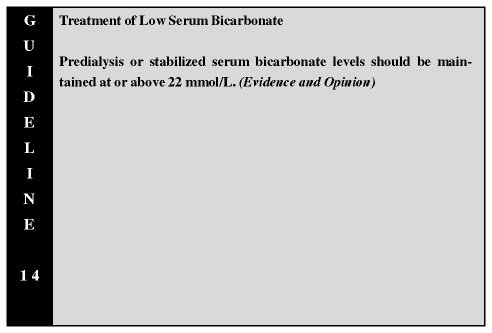
2. Management of Acid-Base Status

Acidemia refers to abnormally increased hydrogen ion concentrations in the blood. Acidosis refers to the existence of one or more conditions that promote acidemia. Acidemia, as measured by serum bicarbonate and/or blood pH, is common in individuals who have CRF or who are undergoing MD. Low serum bicarbonate concentrations in a MD patient almost always indicate metabolic acidosis. Questions concerning the presence or severity of acidemia can be resolved by measuring arterial blood pH and gases. Acidemia due to metabolic acidosis is associated with increased oxidation of branched chain amino acids (valine, leucine, and isoleucine),103 increased protein degradation104 and PNA,105,106 and decreased albumin synthesis.107 Levels of plasma branched chain amino acids have been described to be low in CRF, and a significant direct correlation between plasma bicarbonate levels and free valine concentrations in muscle has been reported in MD patients.108 Similarly, a direct correlation between serum bicarbonate and albumin concentrations has been observed in MHD patients.105,109 Acidemia may have detrimental effects on vitamin D synthesis and bone metabolism and may increase beta-2 microglobulin turnover.110
Normalization of the predialysis or stabilized serum bicarbonate concentration can be achieved by higher basic anion concentrations in the dialysate and/or by oral supplementation with bicarbonate salts. Higher concentrations of bicarbonate in hemodialysate (> 38 mmol/L) has been shown to safely increase predialysis serum bicarbonate concentrations.45,104,111-113 An oral dose of sodium bicarbonate, usually about 2 to 4 g/d or 25 to 50 mEq/d, can be used to effectively increase serum bicarbonate concentrations.109,112,114-116 In individuals undergoing CPD, higher dialysate lactate or bicarbonate levels and oral sodium bicarbonate may each raise serum bicarbonate levels.114,117,118
Correction of acidemia due to metabolic acidosis has been associated with increased serum albumin,119 decreased protein degradation rates,113,114,120 and increased plasma concentrations of branched chain amino acids and total essential amino acids.116,119,121 It has been proposed that eradication of acidemia increases cellular influx and decreases cellular efflux of branched chain amino acids.121 An increase in plasma bicarbonate levels may promote greater body weight gain and increased mid-arm circumference117; a rise in triceps skinfold (TSF) thickness is also reported but is not a consistent finding.113,117 In one long-term study of CPD patients, raising the serum bicarbonate level was associated with fewer hospitalizations and shorter hospital stays.117 Rapid correction of acidemia by bicarbonate infusion has been associated with an increase in serum 1,25(OH)2D3 concentrations122 and a decrease in osteocalcin, suggesting an improvement in osteoblast function.123
A few studies have not found any detrimental effects of mild metabolic acidemia, and some investigators found that small increases in serum bicarbonate concentrations were not associated with significant improvements in nutritional or clinical status.124-126 Indeed, some epidemiological studies report that a slightly increased anion gap, unadjusted for serum creatinine or albumin, is associated with a lower risk of mortality. This latter relationship may be due to greater appetites and protein intake in healthier people. However, most trials report that normalizing the predialysis or stabilized serum bicarbonate concentrations is beneficial for protein, amino acid and bone metabolism, and protein-energy nutritional status.36 Thus, the serum bicarbonate should be monitored regularly at monthly intervals and correction of metabolic acidemia by maintaining serum bicarbonate at or above 22 mmol/L should be a goal of the management of individuals undergoing MD.
There are several technical problems with measuring bicarbonate. The techniques of blood collection and transportation and the assay methods can each influence the measured values. Serum bicarbonate (as total CO2) was found to be significantly lower (about 4 mmol/L) in a reference laboratory when measured by enzymatic assay as compared with when it was measured directly by an electrode.127 Introduction of air into the collecting tube, the technique of removal of blood for assay, and long delays in the measurement can each adversely affect the results. For more accurate values, blood should not be allowed to have contact with air, delays in processing of the sample should be avoided, and the same laboratory and methods of analysis should be used for serial measurements.